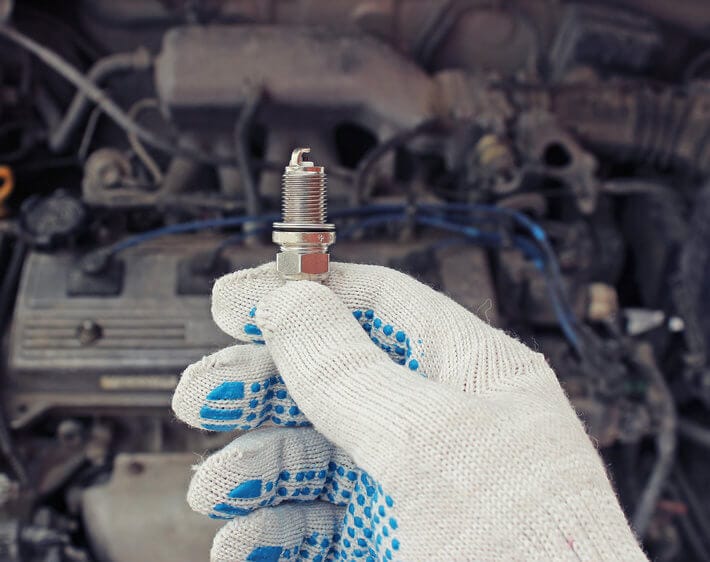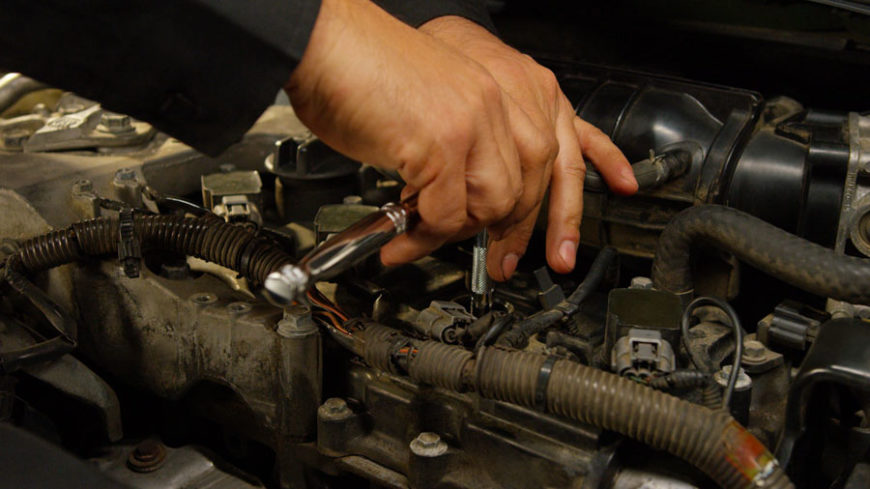Your chariot may boast 200 horsepower, but when a tiny component like a spark plug goes kaput, you’re going nowhere fast. Don’t be the victim of vehicular mutiny; take control! This article takes you on a joyride through the art of spark plug replacements: a skill as essential and age-old as riding a bike… if bikes were gut-less without the combustion of tiny controlled explosions. Squire your wrench, fasten your anti-static wristband, prepare to dive under the hood. You’re about to save yourself a chunk of change and a trip to the auto shop. Revitalizing your ride starts here.
Table of Contents
Understanding the Purpose of a Spark Plug

Beyond those ardent petrolheads or mechanically inclined individuals, many car owners might scratch their heads at mention of this little mechanical marvel – the spark plug. So let’s break it down. In its simplest terms, a spark plug is a crucial component of your car’s internal combustion engine. And yes, it’s about as glamorous as it sounds.
Think of it as a tiny lightning rod, zapping a high voltage spark across an equally minuscule gap to ignite the fuel in your engine’s combustion chamber. Which is pretty much as exciting as that lightning rod hooked to Ben Franklin’s kite, only it involves your trip to the grocery store instead of groundbreaking scientific experiments.
Your spark plug’s core job? To light the fire that ultimately gives ‘go’ to your groceries, taking you from the cereal aisle to your driveway. Each time your engine cycles, your spark plug is right there, dishing out its electrical fury to ignite the air and fuel mixture within the combustion chamber. This spark triggers an explosion – well, a highly controlled one, not some Michael Bay Hollywood spectacle. This explosion generates the necessary force to keep the pistons moving, transmit power to the wheels, and consequently, keep your car in motion.
But it’s not just about engine performance and keeping the pistons prancing. Spark plugs also play a part in your gas mileage. A worn-out or damaged spark plug can cause your engine to misfire. That means your engine is firing but not igniting the fuel, and you essentially end up wasting gas. The result? You find yourself stopping more often at the gas station, which isn’t ideal. The rule of thumb here is, healthy spark plugs, healthy engine; healthy engine, healthier wallet.
There you have it. That’s the nobly unsung role of a spark plug – igniting miniature explosions, keeping your pistons pounding, your car cruising, and your wallet from wincing at the gas pump. But remember, even the mightiest heroes need a helping hand sometimes. So next, we’ll discuss when these little lightning rods need replacing and how you can do it yourself. Stay tuned.
Determining When to Replace Spark Plugs

There’s a vehicular enigma for the ages: when exactly should one switch out their car’s spark plugs? Well, friends, it’s somewhat akin to playing your fave Bruce Springsteen track – too much repetition can lead to diminished quality. Ideally, you’d want to replace your spark plugs every 30,000 miles if they’re standard copper plugs. If you’ve got high-performance spark plugs, however, you could go up to 60,000 or even 90,000 miles before replacement. However, these are not hard-and-fast rules, since other factors such as your driving habits, engine performance and even the specific make of your car impact the longevity of a spark plug.
Like the telltale rumbling of an empty stomach, your vehicle will communicate its spark plug’s health status in a language both nuanced and, to the untrained ear, a smidge cryptic. Here are a few signs that your spark plugs could be playing the automotive equivalent of an out-of-tune piano: you find it harder to start your car, your engine’s running rougher than a singing saw, your fuel consumption has spiked faster than a riveted heart rate. More ominous symptoms include a ‘check engine’ light refusing to turn off, or a failed emissions test.
You could say that replacing your spark plugs is as fundamental as making sure your tires are properly inflated or your windshield wipers aren’t skating across ice-age glaciers. Taking a moment to listen to the music of your engine and replacing your spark plugs when necessary doesn’t just ensure the longevity of your vehicle, but also contributes positively in the pursuit of fuel economy. Drive smart, my car-loving compatriots, and don’t let your spark plugs lose their sparkle.
Collecting the Right Tools

Before you wrench your way into the guts of your engine, you’ve got to make sure you’ve got the right weaponry to take on this mission of spark plug replacement. No cowboy goes into battle without the right steel at his side, and trust me, you’re going to want to be adequately armed for this expedition under the hood.
Your first comrade in arms will be a spark plug socket. This specialty socket is coated on the inside with a padding of rubber or foam to protect the plug as you tighten it down. With a good one, the risk of cracking the porcelain insulator drops virtually to zero. The socket should be either a 5/8 or 13/16 inch, but double-check your spark plug size to assure a snug fit.
Next up, you’re going to need a socket wrench and a spark plug gap gauge. The former for the heaving and ho-ing you’re going to do, and the latter for ensuring the gap between the plug’s electrode and ground is within your engine’s specifications. You might think you can eyeball the gap, but unless you’re a cyborg with laser-precise vision, you’ll want that gap gauge.
A torque wrench also lands on our list of critically important tools. This is used for tightening the spark plug to the specified manufacturer’s torque. Certainly, you could go all caveman on it and just use your raw, untamed strength, but over tightening could cause you to damage the spark plug threads.
A six-inch extension bar comes in handy in the sometimes-claustrophobic quarters of an engine bay, allowing you to reach spark plugs that may be arduously nestled in some hard-to-reach places. If we’re talking about an uncompromising machine like a V8 pickup, you may also need a universal joint to get around those gnarly corners.
And last, but certainly not least, a wire brush or plug cleaning tool. This is to make sure the seating surface for the spark plug is clean and free of debris before you install the new plug. You’d hate to fight your way through the replacement process only to end up with a poorly seated plug, creating a rebellion within your ignition system.
Equipped with these tools, you’ll be more than ready to make the change. It’s the mechanical version of a knight donning his armor, preparing for the clash of steel on steel. Only your dragon is a spark plug, and your battlefield lies beneath the hood of your car.
Steps to Replace a Spark Plug

Okay, so you’ve studied up on the role of your spark plug, recognized the signs your car is screaming for replacement, and you’ve got your tools assembled. Good. Let’s get down to the greasy, dirty fun of actually swapping out those worn-out spark plugs…
Start off by making sure your engine is cool. That metal block has probably been working almost as hard as your mother-in-law criticizes, and it can get hot enough to fry an egg – or your palm. Be patient. Give it time to chill.
Next, you’ll want to blow any dirt or debris from around the coil area. Compressed air can do the trick here. This helps prevent any gunk from falling into the cylinder once the plug is out. It’s like clearing the gemstone before you yank it from an Indiana Jones statue – you don’t want any unpleasant surprises.
Now we move onto disconnecting the spark plug lead. This guy – the spark plug wire – needs a gentle hand. Don’t just yank it by the wire, because that’s a good way to ruin it. Instead, get a firm grasp on the boot – that’s the terminal end – then give it a twist to loosen before pulling free.
Post that, grab your spark plug socket and extension bar. It’s time to unscrew the old spark plug. Lefty-loosy, remember. This needs a steady hand too; any cross-threading can spell disaster for your cylinder head threads.
Once the old gnarly plug has been extracted, bestow it with a farewell along the lines of, “Thanks for your service, old-timer, but it’s time for fresh blood.” Then, grab your new spark plug. Now, here’s a crucial point: always start threading them in by hand. I repeat, by hand. Make sure it’s threading properly. Cross-threading a spark plug is not something you want on your resume.
When the time to apply more force comes, grab your torque wrench. Tighty-righty it nice and snug into place. Now, don’t overdo it. Stripped threads are as welcome as a skunk in an elevator.
Finally, reconnect the spark plug lead, making sure it’s securely seated on the plug.
Bam! You’ve done it. Repeat for other plugs as needed. Now sit back, crack a cold one, and revel in the glory of your mechanical prowess. And remember, if your car doesn’t start after all this, it’s probably time to revisit those steps…or find that can of bus fare you put aside. Seems like being prudent always pays off!
Safety Tips for Spark Plug Replacement
When it comes to the process of replacing your beloved vehicle’s spark plugs, safety should be at the forefront of your mind. Ignoring safety procedures could result in catastrophic results – a hospital visit, a damaged vehicle, or both.
Always remember that you’re working in a potentially volatile environment. Here are some tips to make this project safe and straightforward:
1. Cool It Down: One of the most critical safety precautions is to ensure that your engine is entirely cool before starting the replacement process. An engine that’s been running even a short time can get quite hot! Give it ample time to cool down to avoid burns.
2. Eye Protection: Small particles and debris can easily fly when you’re pulling out old plugs and installing new ones. Therefore, a comfortable pair of safety glasses is a must to shield your eyes.
3. Use Insulated Tools: Electricity can be a nasty surprise if you underestimate it. Using insulated tools can help prevent accidental shocks from any residual current.
4. Don’t Force Things: If a spark plug doesn’t want to come out or go in smoothly, don’t force it. You could strip the threads, leading to a costlier repair job.
5. Clear The Area: Before installing your new spark plugs, it’s crucial to blow or clean out the spark plug well, ensuring no debris gets into your engine.
6. Think Tidy: A well-organized work area can do wonders. Keep your tools organized to prevent accidents like tripping or knocking something into the engine.
Remember, safety is not a privilege but your right when working on your vehicle. By taking these precautions, you’re ensuring a hazard-free spark plug replacement process, giving your vehicle a fresh spark of life. After all, it’s better to be safe than sorry.
FAQs
Why should I replace my own spark plugs?
What tools do I need to replace a spark plug?
How often should I replace my spark plugs?
Conclusion
In conclusion, replacing your spark plugs isn’t as daunting as it seems. This process riddled with grease, rust, and grit can certainly be intimidating. But with the right tools, a little patience, and this guide in everybody’s garage, it’s a job most people can tackle. Just remember: never rush, always follow safety guidelines, and enjoy the pride of maintaining your ride. Yet, if you smell a whiff of uncertainty or hesitation, there’s no shame in delegating this task to professionals. Happy wrenching or smart delegating—choose your own car care adventure.
